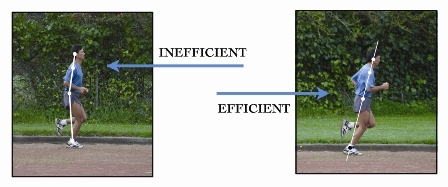Mark will be hosting a FREE INTRODUCTORY CLINIC about running injury free this Thursday, May 13, from 6:30-7:30pm at the 700 East location. This clinic will focus on the basics of Chi Running.
This Friday-Saturday, May 14-15, join Mark for a weekend workshop so you, too, can use the Chi Running way of running to stay injury free through the miles.
By Mark Wallis
Certified ChiRunning Instructor
 It doesn’t matter if you’re a seasoned runner with multiple marathons under your belt or a beginning runner unsure of how to proceed with a running program; we all share the common goal of avoiding injuries. But running injuries are not inevitable. Many people suffer through serious aches and pains commonly associated with running simply because they don’t know what’s causing the problem. Remember, it’s not the act of running that hurts your body, it’s the way you run that can be the problem.
It doesn’t matter if you’re a seasoned runner with multiple marathons under your belt or a beginning runner unsure of how to proceed with a running program; we all share the common goal of avoiding injuries. But running injuries are not inevitable. Many people suffer through serious aches and pains commonly associated with running simply because they don’t know what’s causing the problem. Remember, it’s not the act of running that hurts your body, it’s the way you run that can be the problem.
The information I present is based on my background and training as a ChiRunning Instructor, RRCA Distance Coach and a Team In Training Marathon Running and Walking Coach.
Knowing what causes injuries is the first step in understanding how to avoid them when you go running. In most cases the cause of injuries is due to repetitive stress or overuse of body parts trying to move in a way the body was not designed to be used.
Let’s go over a few of the most common problems:
Over Striding
When you’re running and your feet are landing in front of your hips there’s a braking action that takes place with every step. The force of the body hitting the ground in front of your hips creates an energy that must go somewhere. Usually it will find the weakest link in your body; ankles, shins, knees, hips, lower back etc. Everyone has their own unique weak link and that’s one reason why running injuries can take form in so many different places.
Heel Strike
When you allow your heel to be the initial contact with the ground (usually in combination with Over Striding) you are creating a tremendous amount of impact force. This sends a shock wave through your body and will find your weakest link. There’s been a lot of attention on barefoot running in the press recently. I enjoy running barefoot and embrace the concept of letting our feet educate our body and improve our form. I personally feel that properly fitted running shoes are the best way to go for most people. However, a running shoe will only spread the impact force over a slightly larger area; it won’t eliminate the problems of heel striking. You must pay attention to your form and work at reducing the amount of heel striking. Once you’re landing “mid-foot” or “full-foot”, under your hips, the amount of impact force is reduced.
Toe push-off
Running on the balls of your feet and using a toe push-off for every step will lead to lots of lower leg and foot injuries. You would be relying on your calf muscles to propel your body forward every single step. That’s asking these small leg muscles to carry more weight and work harder than they need. One of the keys in good running form is relaxing as many muscles in your body as possible. A relaxed muscle is less likely to be injured while running. So unless you’re competing in short distances on a track I suggest you stay off your toes.
Now let’s focus on things that will help keep you injury free and running for the rest of your life.
Listen to Your Body…
In order to train your body to know when it’s running correctly you must first open up the communication between your body and your mind. It’s called “Body Sensing”. Consider it a way of listening with your body and then responding with your mind. You will become your own detective and take an active role in finding out what your body is doing while you run.
Remove your headphones, focus your mind and perform a body sweep. Moving from area to area making mental notes of what you find. Move from your head to neck, shoulders, arms, fingers, chest, abdomen, lower back, hips, upper legs, knees, lower legs, feet and toes. As you do this ask questions: Do I feel tension or relaxation here? Is it heavy or light, soft, open or hard? Are your feet softly landing or slapping the ground on each step? Do your heels end up scrapping after a few miles? How about your lower back, is there a dull soreness that appears after a few minutes of running? Can you notice a change in your breathing during the first mile compared to the last mile? Move the focus to your shoulders; are you holding tension in this area? Turn the focus to your fingers and toes; are they relaxed or clenched and holding tension? During your next run perform this mental body scan and locate which muscles are tired. One of your goals will be relaxing as many muscles as possible. Relaxation can be thought of as the absence of unnecessary effort. The purpose of Body Sensing is to build a base of knowledge from which you will respond with correct action.
Posture….
Good running form starts with properly aligned posture. This can be described as a straight line linking your shoulders, hips and ankles. This straight line can be called your column. When your column is aligned properly your body will be supported by bones, ligaments and tendons not your muscles. Why is this important? Try this demonstration; stand up tall and walk in place for 10 seconds. Now add a slight bend forward at the waist and continue walking in place for 10 more seconds. Now switch back to a tall posture while you walk for a few more seconds. Did you feel the extra muscles being used in your legs, lower back and neck when bent over? This is because your body was out of alignment and muscles had to kick in and do the job of keeping us upright. Next time you see a group of runners take note of their posture. Most runners end up bent forward at the waist while running. No wonder so many people complain about feeling sore after a run!
So how do you maintain this column during a run?
The easy answer is to “level your pelvis and engage your core.” However, the reality is everyone has their own unique form of posture and making changes can take time. When we engage the deep muscles of the abdomen and create a strong core it allows the body to be supported by its structure rather than muscles. An engaged core takes the pressure off your lower back, keeps your hips from rocking side to side (which could lead to IT Band issues) and keeps the upper and lower body properly aligned. Try this; while standing in your best posture put the palm of your hand just below your belly button and the back of the other hand on your sacrum. Now gently raise the front of your pelvis and feel for a slight engagement of the lower abs. This slight engagement of the abs is a similar feeling to trying to zip up tight pants and you need to suck in for the last part of the zipping process. While doing this try to keep your glutes relaxed, if they are holding tension while you level your pelvis then you’ll need to relax and try again. You just need enough core engagement to level your pelvis but without clenching your butt. Now just stand there and do some Body Sensing of what this feels like. When you go running you’ll need to recreate this column in order to lean from the ankles and relax the rest of your body.
Mark Wallis is a 2nd generation native Tucsonan and enjoys helping people reach their running goals and stay injury free in the process. He’s a certified ChiRunning Instructor and conducts workshops in the western United States. To learn more about ChiRunning visit www.chirunning.com or email [email protected]
